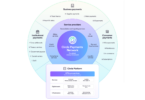At last week’s IBM Think conference in San Francisco, Jesse Lund, IBM’s Head of Blockchain Solutions, Financial Services, gave an interview to Finder.com. During the discussion he provided details about the functionality of the IBM World Wire cross border payments network.
Although IBM uses Hyperledger Fabric for many enterprise blockchain applications, it adopted the Stellar protocol for World Wire because it’s uniquely suited to payments. Lumens is Stellar’s digital currency.
Below are some excerpts from the interview.
What is World Wire?
Lund: “The architecture of World Wire is really a cross border payment network. The novelty is the ability to send payment messaging instructions saying hey ‘I’m sending you something, get ready.’ And on the other end, the receiver is making sure that who you’re sending it to is not some nefarious or bad actor. Once that happens, and it happens really fast, then we send the value along with it.”
“The transfer of value is made possible by an ecosystem of digital instruments, settlement instruments, digital assets, of which [Stellar] Lumens is one. We see Lumens as a viable settlement instrument in this ecosystem of cross border payments.”
How World Wire compares with Ripple
Lund: “Credit to Ripple for the vision of using a digital asset in order to enact immediate settlement with finality. Their implementation follows one path. Our implementation is a little bit different.”
“We’re not the issuer of an asset. In fact, we believe there should be an ecosystem or variety of digital assets that provide settlement instruments that enable these cross border payments. And the participants on the network should be able to choose and negotiate their choices in real time, and the pricing might be different depending on the settlement instruments you use.”
“So with Ripple, I think they’re looking at XRP as the primary digital asset for settlement. For us it could be Lumens, it could be Ripple it could be XRP, it could be Bitcoin. It would also probably include other instruments like stablecoins and even eventually, soon hopefully, central bank issued digital currencies.”
Who provides World Wire?
Lund: “World Wire is the network, and IBM’s long game in this is to be the network operator. The subscribers, the customers if you will, of World Wire are the market makers who really provide the pay in and pay out locations. And they themselves have corporate clients and probably retail clients, so they’ve got their own client base.”
“We’re really providing the conduit, the pipeline if you will, through which money can flow in real-time. And the customers are the market makers that enable this real-time FX to happen.”
How are Stellar Lumens used on the network?
Lund: “In general it’s used as what we’d think of as gas. It powers transactions on the network. Transactions have a very small cost. And really that is just a deterrent to prevent bad actors from spamming the network and bringing the network down.”
“There has to be a cost of transaction, but it’s very low. Its primary point is not to make money. Its primary point is to deter bad behavior. That’s one way that Lumens are used, and that’s fundamental to the protocol itself.”
“In World Wire, we use Lumens as a settlement instrument. So if someone is sending money between Canada and Brazil – I just picked these at random – there is really no direct trading pair that I know of between Canadian Dollars and Brazilian Reals. It has to trade through an intermediate currency. We talk about that FX happening in real-time. It happens through an intermediate store of value that is a digital asset.”
“We talk about the variety of digital assets that we support, and Lumens is one of them. So you can send money from Canada to Brazil. But what is happening that you don’t really see is that it’s moving money through Lumens.”
The roadmap
Lund: “Our goal is to continue to expand the network, inviting more participants to join. It doesn’t cost anything to join the network. You kind of pay for what you use. As you’re moving money, we capture a small fee for the money flowing through the network, to be the network operator, to maintain it.”
“We hope to have within 3-5 years hundreds of endpoints, hundreds of operators that are providing access to these endpoints. And really enabling us to have global coverage.”
“The ability to send money from any place in the world to any other place in the world across all currencies, in real-time at a really low fee. That’s the goal for this.”






